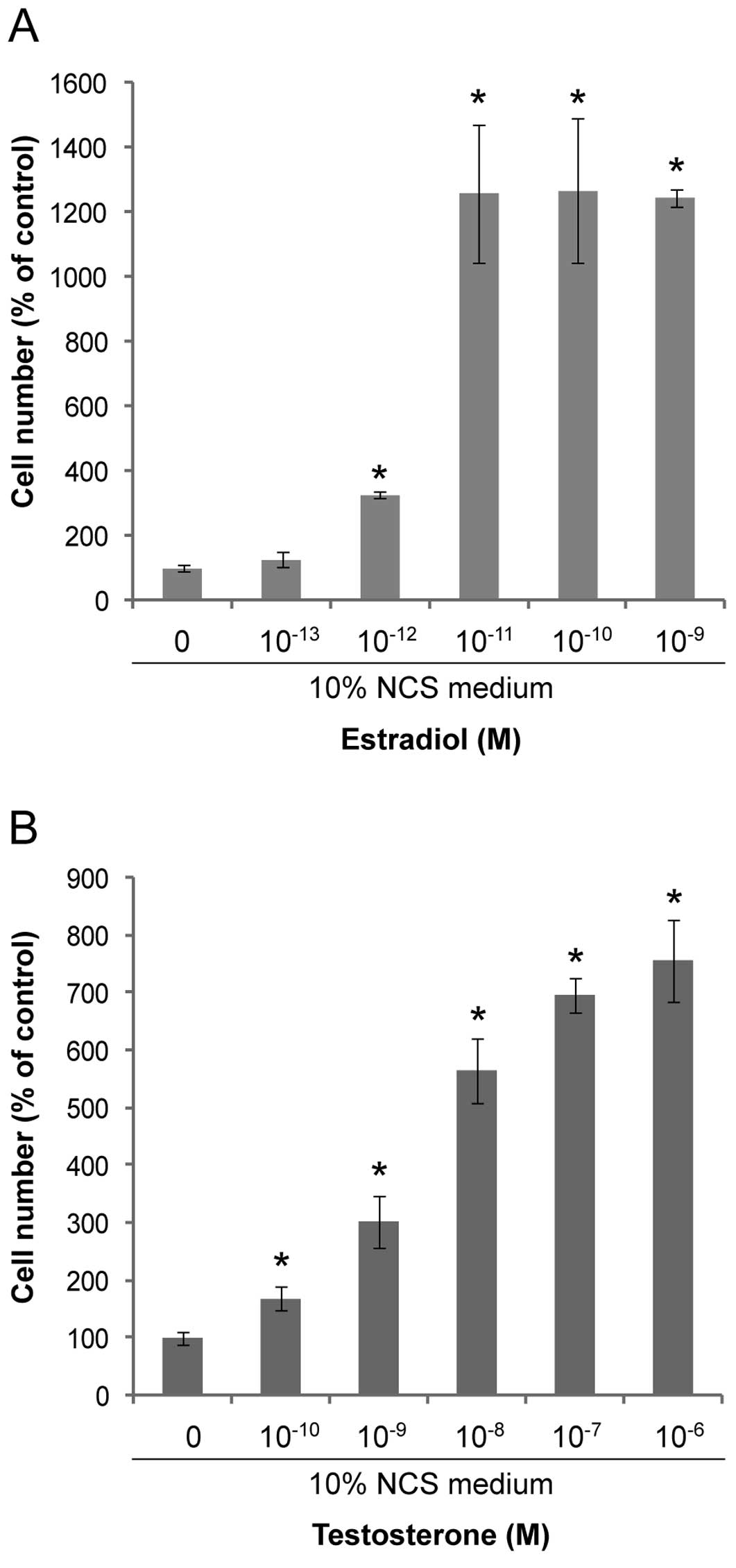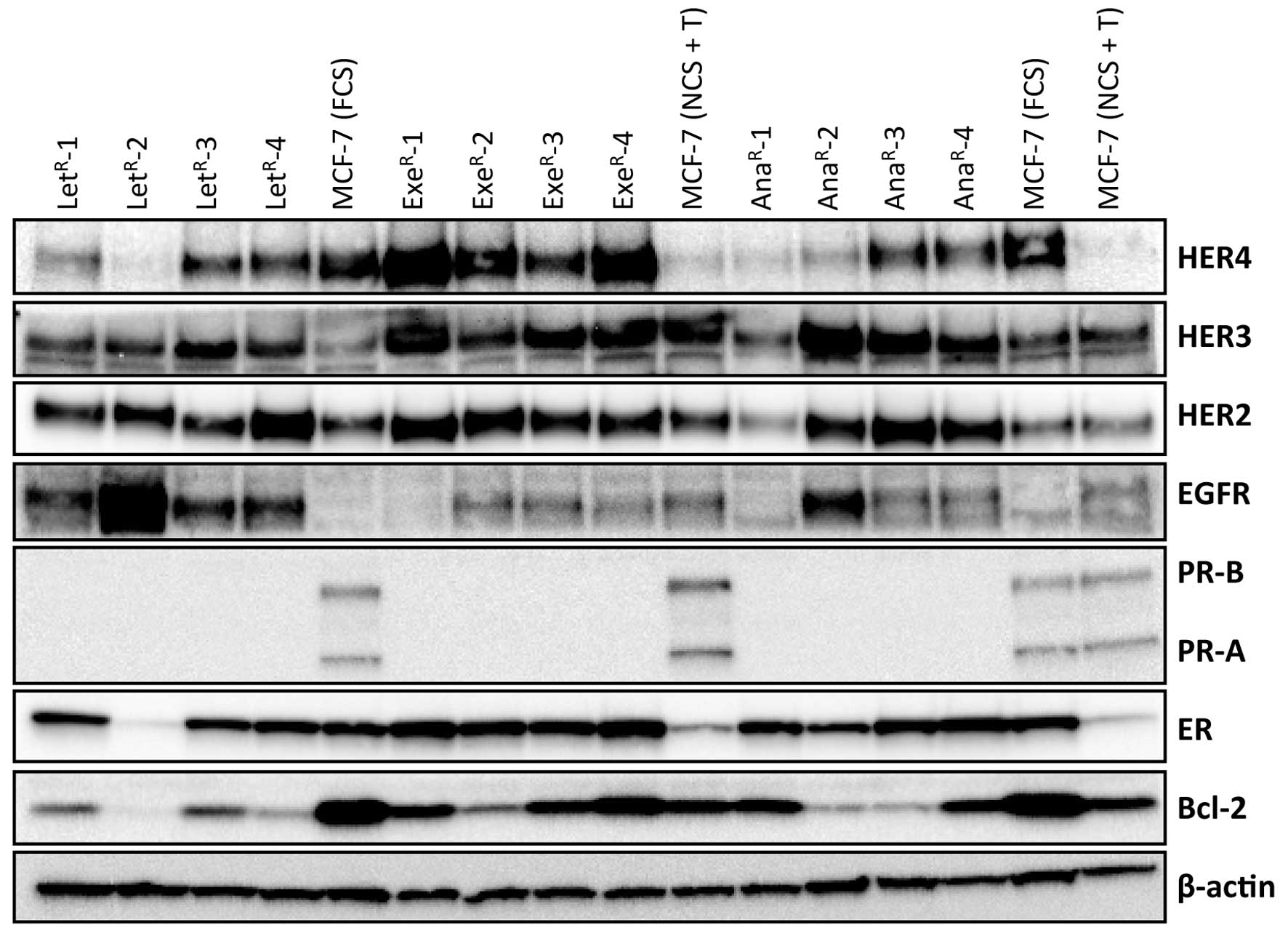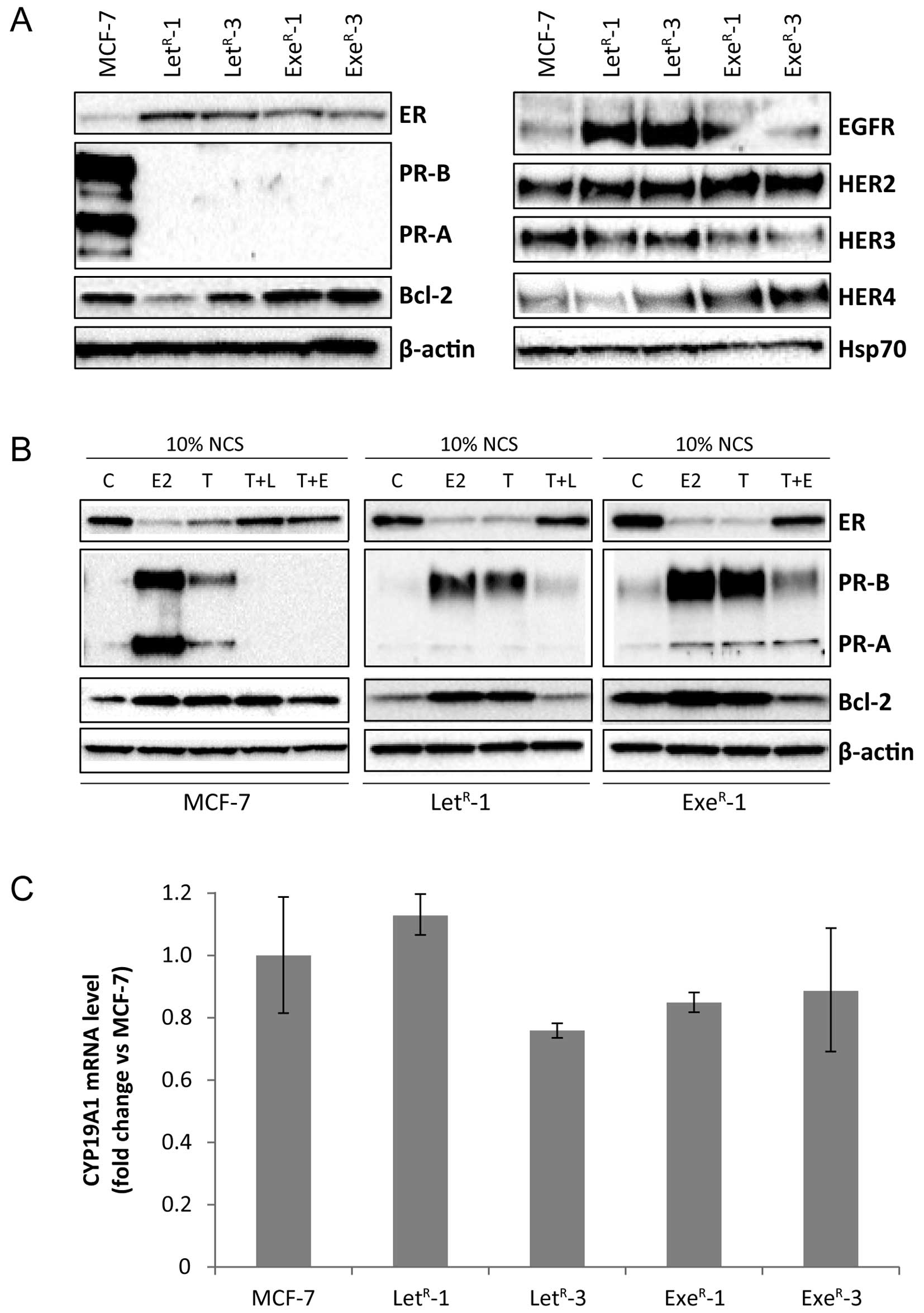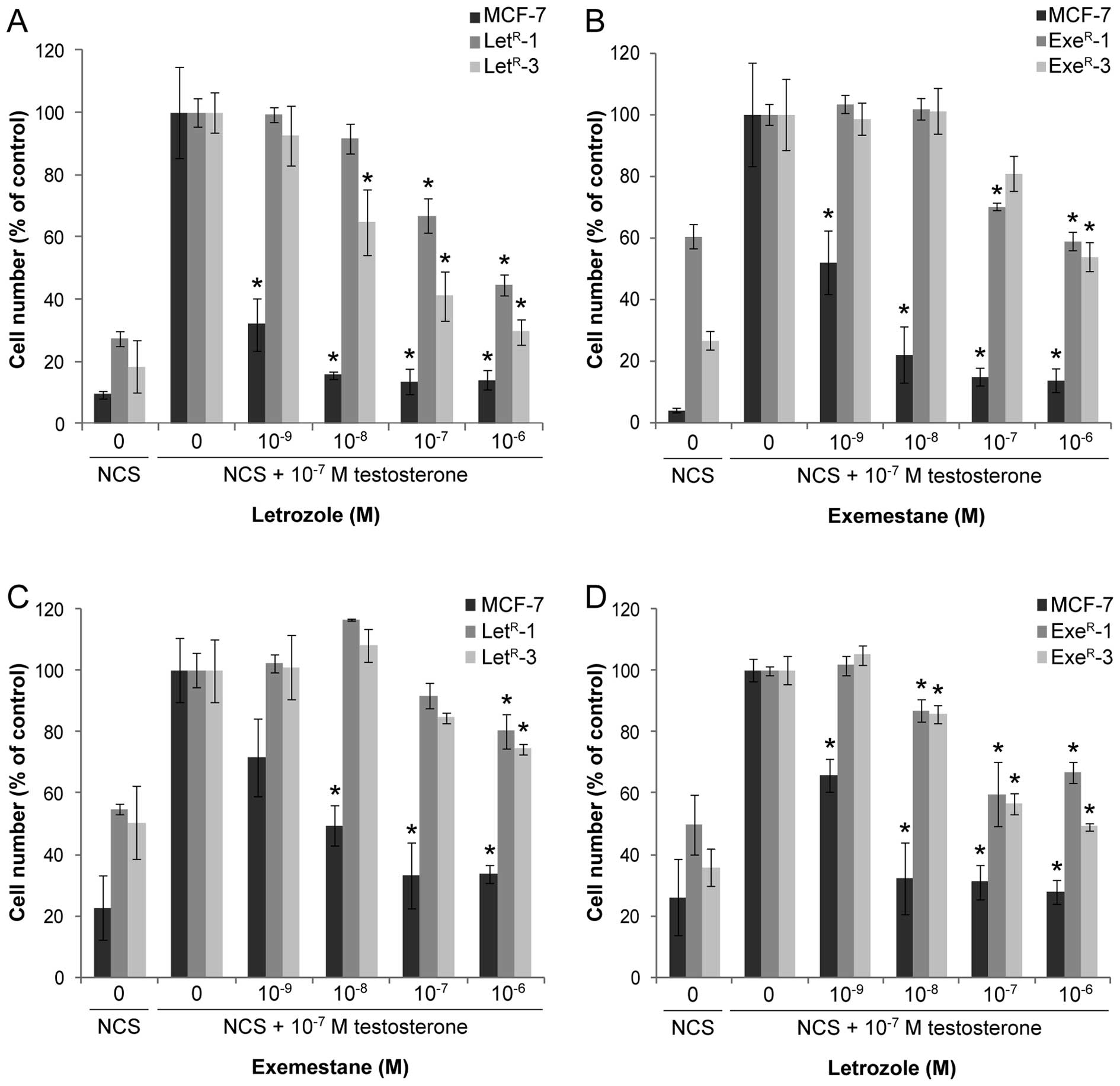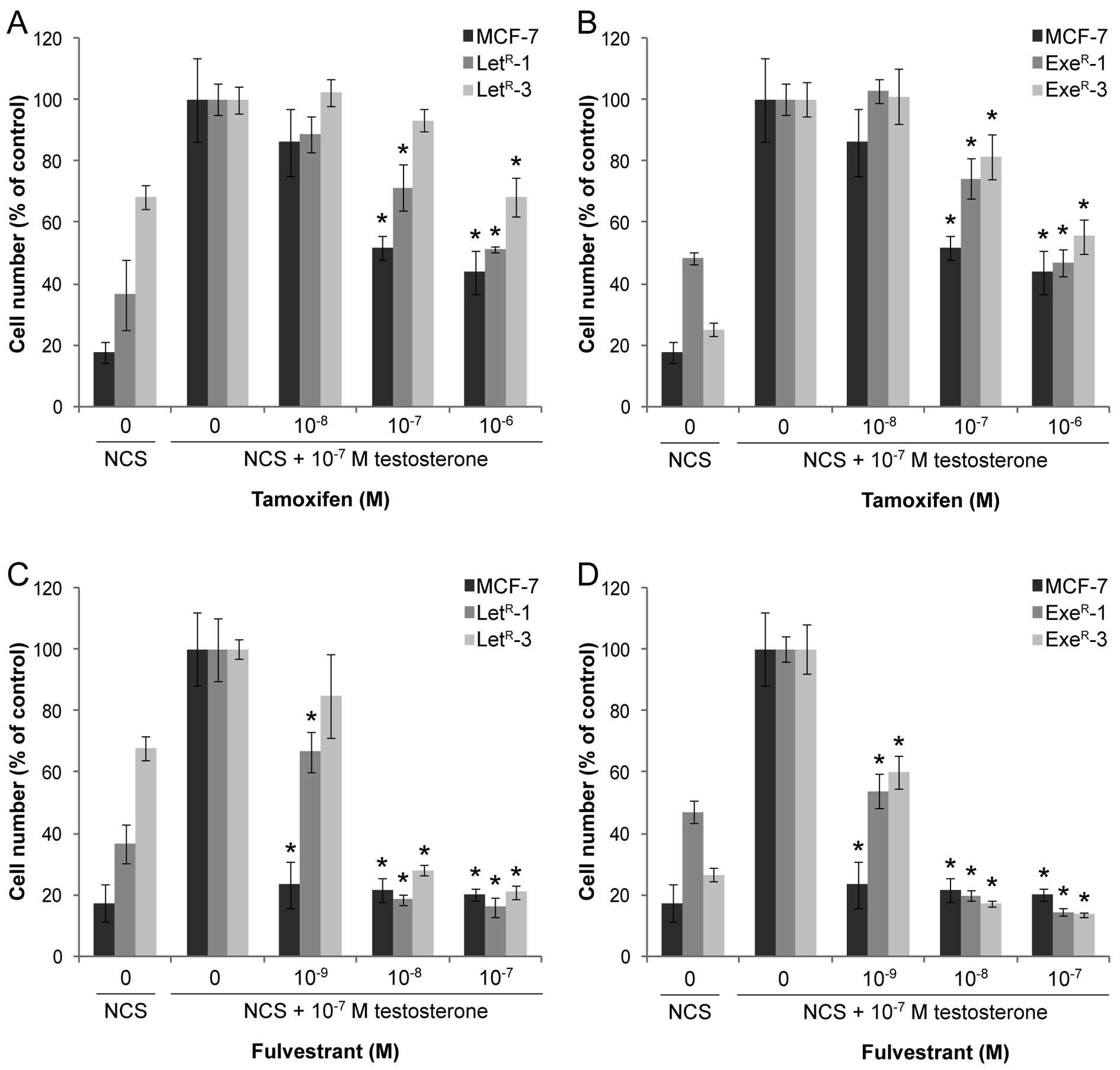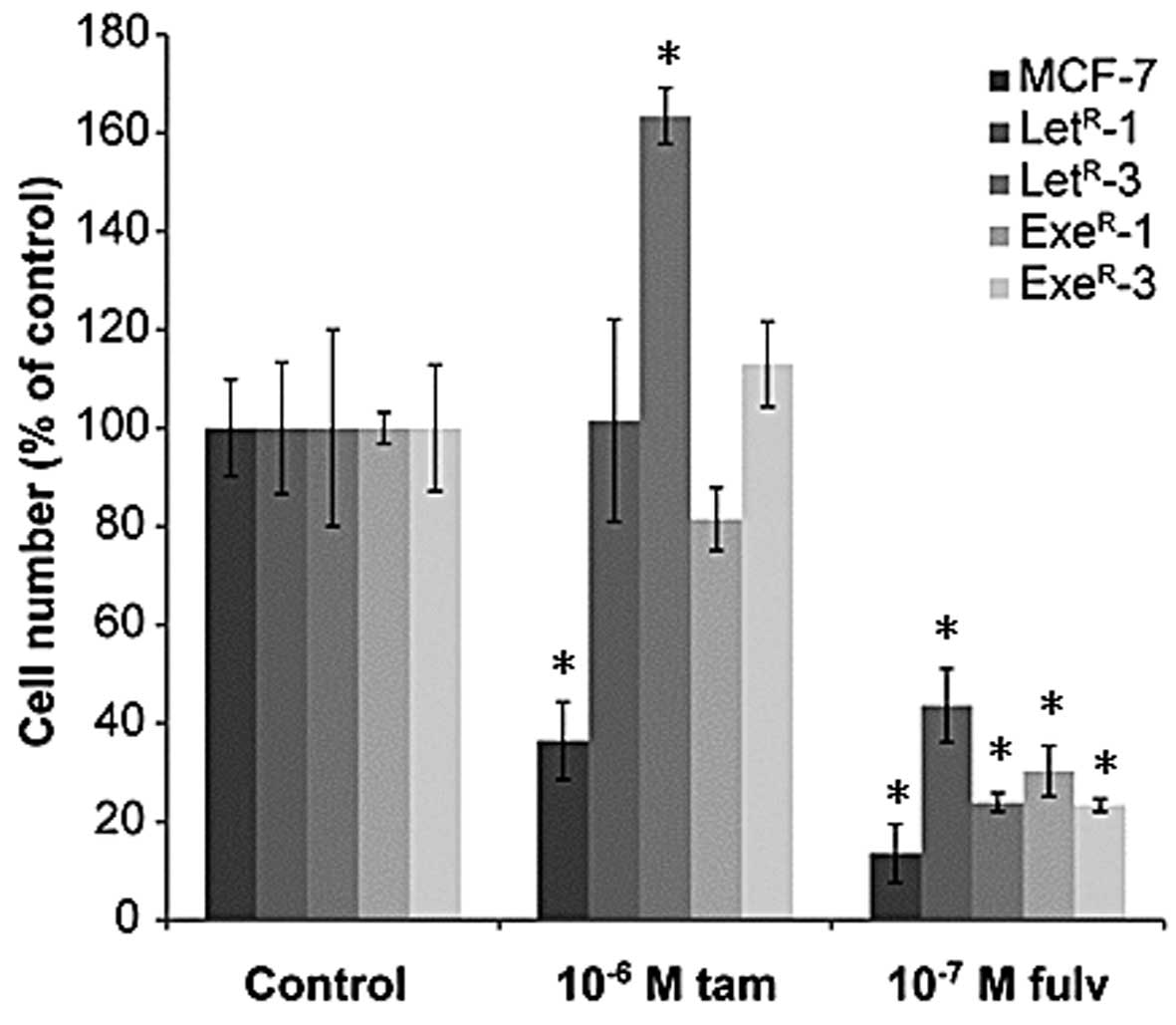|
1
|
Early Breast Cancer Trialists’
Collaborative Group. Davies C, Godwin J, et al: Relevance of breast
cancer hormone receptors and other factors to the efficacy of
adjuvant tamoxifen: patient-level meta-analysis of randomised
trials. Lancet. 378:771–784. 2011. View Article : Google Scholar : PubMed/NCBI
|
|
2
|
Mouridsen H, Gershanovich M, Sun Y, et al:
Superior efficacy of letrozole versus tamoxifen as first-line
therapy for postmenopausal women with advanced breast cancer:
results of a phase III study of the International Letrozole Breast
Cancer Group. J Clin Oncol. 19:2596–2606. 2001.PubMed/NCBI
|
|
3
|
Nabholtz JM, Buzdar A, Pollak M, et al:
Anastrozole is superior to tamoxifen as first-line therapy for
advanced breast cancer in postmenopausal women: results of a North
American multicenter randomized trial. Arimidex Study Group J Clin
Oncol. 18:3758–3767. 2000.
|
|
4
|
Paridaens RJ, Dirix LY, Beex LV, et al:
Phase III study comparing exemestane with tamoxifen as first-line
hormonal treatment of metastatic breast cancer in postmenopausal
women: the European Organisation for Research and Treatment of
Cancer Breast Cancer Cooperative Group. J Clin Oncol. 26:4883–4890.
2008. View Article : Google Scholar : PubMed/NCBI
|
|
5
|
Dowsett M, Cuzick J, Ingle J, et al:
Meta-analysis of breast cancer outcomes in adjuvant trials of
aromatase inhibitors versus tamoxifen. J Clin Oncol. 28:509–518.
2010. View Article : Google Scholar
|
|
6
|
Goldhirsch A, Wood WC, Coates AS, et al:
Strategies for subtypes - dealing with the diversity of breast
cancer: highlights of the St. Gallen International Expert Consensus
on the Primary Therapy of Early Breast Cancer 2011. Ann Oncol.
22:1736–1747. 2011. View Article : Google Scholar : PubMed/NCBI
|
|
7
|
Schwartzberg LS, Franco SX, Florance A,
O’Rourke L, Maltzman J and Johnston S: Lapatinib plus letrozole as
first-line therapy for HER-2+ hormone receptor-positive
metastatic breast cancer. Oncologist. 15:122–129. 2010. View Article : Google Scholar
|
|
8
|
Baselga J, Campone M, Piccart M, et al:
Everolimus in post-menopausal hormone-receptor-positive advanced
breast cancer. N Engl J Med. 366:520–529. 2012. View Article : Google Scholar
|
|
9
|
Burris HA III: Overcoming acquired
resistance to anticancer therapy: focus on the PI3K/AKT/mTOR
pathway. Cancer Chemother Pharmacol. 71:829–842. 2013. View Article : Google Scholar : PubMed/NCBI
|
|
10
|
Miller WR: Aromatase inhibitors:
prediction of response and nature of resistance. Expert Opin
Pharmacother. 11:1873–1887. 2010. View Article : Google Scholar : PubMed/NCBI
|
|
11
|
Arnedos M, Drury S, Afentakis M, et al:
Biomarker changes associated with the development of resistance to
aromatase inhibitors (AIs) in estrogen receptor-positive breast
cancer. Ann Oncol. 25:605–610. 2014. View Article : Google Scholar : PubMed/NCBI
|
|
12
|
Bulun SE, Sebastian S, Takayama K, Suzuki
T, Sasano H and Shozu M: The human CYP19 (aromatase P450) gene:
update on physiologic roles and genomic organization of promoters.
J Steroid Biochem Mol Biol. 86:219–224. 2003. View Article : Google Scholar : PubMed/NCBI
|
|
13
|
Lykkesfeldt AE, Henriksen KL, Rasmussen
BB, et al: In situ aromatase expression in primary tumor is
associated with estrogen receptor expression but is not predictive
of response to endocrine therapy in advanced breast cancer. BMC
Cancer. 9:1852009. View Article : Google Scholar : PubMed/NCBI
|
|
14
|
Haynes BP, Straume AH, Geisler J, et al:
Intratumoral estrogen disposition in breast cancer. Clin Cancer
Res. 16:1790–1801. 2010. View Article : Google Scholar : PubMed/NCBI
|
|
15
|
Lonning PE, Haynes BP, Straume AH, et al:
Recent data on intratumor estrogens in breast cancer. Steroids.
76:786–791. 2011. View Article : Google Scholar : PubMed/NCBI
|
|
16
|
Briand P and Lykkesfeldt AE: Long-term
cultivation of a human breast cancer cell line, MCF-7, in a
chemically defined medium. Effect of estradiol. Anticancer Res.
6:85–90. 1986.PubMed/NCBI
|
|
17
|
Masamura S, Santner SJ, Heitjan DF and
Santen RJ: Estrogen deprivation causes estradiol hypersensitivity
in human breast cancer cells. J Clin Endocrinol Metab.
80:2918–2925. 1995.PubMed/NCBI
|
|
18
|
Chan CM, Martin LA, Johnston SR, Ali S and
Dowsett M: Molecular changes associated with the acquisition of
oestrogen hypersensitivity in MCF-7 breast cancer cells on
long-term oestrogen deprivation. J Steroid Biochem Mol Biol.
81:333–341. 2002. View Article : Google Scholar : PubMed/NCBI
|
|
19
|
Coutts AS and Murphy LC: Elevated
mitogen-activated protein kinase activity in estrogen-nonresponsive
human breast cancer cells. Cancer Res. 58:4071–4074.
1998.PubMed/NCBI
|
|
20
|
Pink JJ, Jiang SY, Fritsch M and Jordan
VC: An estrogen-independent MCF-7 breast cancer cell line which
contains a novel 80-kilodalton estrogen receptor-related protein.
Cancer Res. 55:2583–2590. 1995.PubMed/NCBI
|
|
21
|
Martin LA, Farmer I, Johnston SR, Ali S,
Marshall C and Dowsett M: Enhanced estrogen receptor (ER) alpha,
ERBB2, and MAPK signal transduction pathways operate during the
adaptation of MCF-7 cells to long term estrogen deprivation. J Biol
Chem. 278:30458–30468. 2003. View Article : Google Scholar : PubMed/NCBI
|
|
22
|
Jensen J, Kitlen JW, Briand P, Labrie F
and Lykkesfeldt AE: Effect of antiestrogens and aromatase inhibitor
on basal growth of the human breast cancer cell line MCF-7 in
serum-free medium. J Steroid Biochem Mol Biol. 84:469–478. 2003.
View Article : Google Scholar : PubMed/NCBI
|
|
23
|
Santen RJ, Song RX, Zhang Z, et al:
Long-term estradiol deprivation in breast cancer cells up-regulates
growth factor signaling and enhances estrogen sensitivity. Endocr
Relat Cancer. 12(Suppl 1): S61–S73. 2005. View Article : Google Scholar : PubMed/NCBI
|
|
24
|
Staka CM, Nicholson RI and Gee JM:
Acquired resistance to oestrogen deprivation: role for growth
factor signalling kinases/oestrogen receptor cross-talk revealed in
new MCF-7X model. Endocr Relat Cancer. 12(Suppl 1): S85–S97. 2005.
View Article : Google Scholar : PubMed/NCBI
|
|
25
|
Sabnis G and Brodie A: Adaptive changes
results in activation of alternate signaling pathways and
resistance to aromatase inhibitor resistance. Mol Cell Endocrinol.
340:142–147. 2011. View Article : Google Scholar
|
|
26
|
Martin LA, Ghazoui Z, Weigel MT, et al: An
in vitro model showing adaptation to long-term oestrogen
deprivation highlights the clinical potential for targeting kinase
pathways in combination with aromatase inhibition. Steroids.
76:772–776. 2011. View Article : Google Scholar : PubMed/NCBI
|
|
27
|
Miller TW, Balko JM, Fox EM, et al:
ERalpha-dependent E2F transcription can mediate resistance to
estrogen deprivation in human breast cancer. Cancer Discov.
1:338–351. 2011. View Article : Google Scholar : PubMed/NCBI
|
|
28
|
Zhou DJ, Pompon D and Chen SA: Stable
expression of human aromatase complementary DNA in mammalian cells:
a useful system for aromatase inhibitor screening. Cancer Res.
50:6949–6954. 1990.PubMed/NCBI
|
|
29
|
Sun XZ, Zhou D and Chen S: Autocrine and
paracrine actions of breast tumor aromatase. A three-dimensional
cell culture study involving aromatase transfected MCF-7 and T-47D
cells. J Steroid Biochem Mol Biol. 63:29–36. 1997. View Article : Google Scholar
|
|
30
|
Macaulay VM, Nicholls JE, Gledhill J,
Rowlands MG, Dowsett M and Ashworth A: Biological effects of stable
overexpression of aromatase in human hormone-dependent breast
cancer cells. Br J Cancer. 69:77–83. 1994. View Article : Google Scholar : PubMed/NCBI
|
|
31
|
Masri S, Phung S, Wang X, et al:
Genome-wide analysis of aromatase inhibitor-resistant,
tamoxifen-resistant, and long-term estrogen-deprived cells reveals
a role for estrogen receptor. Cancer Res. 68:4910–4918. 2008.
View Article : Google Scholar : PubMed/NCBI
|
|
32
|
Brodie A, Jelovac D, Sabnis G, Long B,
Macedo L and Goloubeva O: Model systems: mechanisms involved in the
loss of sensitivity to letrozole. J Steroid Biochem Mol Biol.
95:41–48. 2005. View Article : Google Scholar : PubMed/NCBI
|
|
33
|
Masri S, Phung S, Wang X and Chen SA:
Molecular characterization of aromatase inhibitor-resistant,
tamoxifen-resistant and LTEDaro cell lines. J Steroid Biochem Mol
Biol. 118:277–282. 2010. View Article : Google Scholar :
|
|
34
|
Wang X, Masri S, Phung S and Chen SU: The
role of amphi-regulin in exemestane-resistant breast cancer cells:
evidence of an autocrine loop. Cancer Res. 68:2259–2265. 2008.
View Article : Google Scholar : PubMed/NCBI
|
|
35
|
Sonne-Hansen K and Lykkesfeldt AE:
Endogenous aromatization of testosterone results in growth
stimulation of the human MCF-7 breast cancer cell line. J Steroid
Biochem Mol Biol. 93:25–34. 2005. View Article : Google Scholar : PubMed/NCBI
|
|
36
|
Lundqvist J, Hansen SK and Lykkesfeldt AE:
Vitamin D analog EB1089 inhibits aromatase expression by
dissociation of comodulator WSTF from the CYP19A1 promoter-a new
regulatory pathway for aromatase. Biochim Biophys Acta. 1833.40–47.
2013.
|
|
37
|
Briand P and Lykkesfeldt AE: Effect of
estrogen and anti-estrogen on the human breast cancer cell-line
MCF-7 adapted to growth at low serum concentration. Cancer Res.
44:1114–1119. 1984.PubMed/NCBI
|
|
38
|
Lundholt BK, Briand P and Lykkesfeldt AE:
Growth inhibition and growth stimulation by estradiol of estrogen
receptor transfected human breast epithelial cell lines involve
different pathways. Breast Cancer Res Treat. 67:199–214. 2001.
View Article : Google Scholar : PubMed/NCBI
|
|
39
|
Larsen MS, Yde CW, Christensen IJ and
Lykkesfeldt AE: Carboplatin treatment of antiestrogen-resistant
breast cancer cells. Int J Oncol. 41:1863–1870. 2012.PubMed/NCBI
|
|
40
|
Diaz-Cruz ES, Shapiro CL and Brueggemeier
RW: Cyclo-oxygenase inhibitors suppress aromatase expression and
activity in breast cancer cells. J Clin Endocrinol Metab.
90:2563–2570. 2005. View Article : Google Scholar
|
|
41
|
Thrane S, Lykkesfeldt AE, Larsen MS,
Sorensen BS and Yde CW: Estrogen receptor alpha is the major
driving factor for growth in tamoxifen-resistant breast cancer and
supported by HER/ERK signaling. Breast Cancer Res Treat. 139:71–80.
2013. View Article : Google Scholar : PubMed/NCBI
|
|
42
|
Frogne T, Benjaminsen RV, Sonne-Hansen K,
et al: Activation of ErbB3, EGFR and Erk is essential for growth of
human breast cancer cell lines with acquired resistance to
fulvestrant. Breast Cancer Res Treat. 114:263–275. 2009. View Article : Google Scholar :
|
|
43
|
Nicholson RI, Hutcheson IR, Jones HE, et
al: Growth factor signalling in endocrine and anti-growth factor
resistant breast cancer. Rev Endocr Metab Disord. 8:241–253. 2007.
View Article : Google Scholar : PubMed/NCBI
|
|
44
|
Morrison G, Fu X, Shea M, et al:
Therapeutic potential of the dual EGFR/HER2 inhibitor AZD8931 in
circumventing endocrine resistance. Breast Cancer Res Treat.
144:263–272. 2014. View Article : Google Scholar : PubMed/NCBI
|
|
45
|
Weigel MT GZ, Dunbier A, Pancholi S,
Dowsett M and Martin LA: Preclinical and clinical studies of
estrogen deprivation support the PDGF/Abl pathway as a novel
therapeutic target for overcoming endocrine resistance in breast
cancer. Breast Cancer Res. 14:R782012. View Article : Google Scholar : PubMed/NCBI
|
|
46
|
Brodie A, Macedo L and Sabnis G: Aromatase
resistance mechanisms in model systems in vivo. J Steroid Biochem
Mol Biol. 118:283–287. 2010. View Article : Google Scholar
|
|
47
|
Liu S, Meng X, Chen H, et al: Targeting
tyrosine-kinases and estrogen receptor abrogates resistance to
endocrine therapy in breast cancer. Oncotarget. 5:9049–9064.
2014.PubMed/NCBI
|
|
48
|
Jensen BL, Skouv J, Lundholt BK and
Lykkesfeldt AE: Differential regulation of specific genes in MCF-7
and the ICI 182780-resistant cell line MCF-7/182(R)-6. Br J Cancer.
79:386–392. 1999. View Article : Google Scholar : PubMed/NCBI
|
|
49
|
Dauvois S, Danielian PS, White R and
Parker MG: Antiestrogen ICI 164,384 reduces cellular estrogen
receptor content by increasing its turnover. Proc Natl Acad Sci
USA. 89:4037–4041. 1992. View Article : Google Scholar : PubMed/NCBI
|
|
50
|
Long BJ, Jelovac D, Thiantanawat A and
Brodie AM: The effect of second-line antiestrogen therapy on breast
tumor growth after first-line treatment with the aromatase
inhibitor letrozole: long-term studies using the intratumoral
aromatase postmenopausal breast cancer model. Clin Cancer Res.
8:2378–2388. 2002.PubMed/NCBI
|
|
51
|
Chia S, Gradishar W, Mauriac L, et al:
Double-blind, randomized placebo controlled trial of fulvestrant
compared with exemestane after prior nonsteroidal aromatase
inhibitor therapy in post-menopausal women with hormone
receptor-positive, advanced breast cancer: results from EFECT. J
Clin Oncol. 26:1664–1670. 2008. View Article : Google Scholar : PubMed/NCBI
|
|
52
|
Johnston SR, Kilburn LS, Ellis P, et al:
Fulvestrant plus anastrozole or placebo versus exemestane alone
after progression on non-steroidal aromatase inhibitors in
postmenopausal patients with hormone-receptor-positive locally
advanced or metastatic breast cancer (SoFEA): a composite,
multicentre, phase 3 randomised trial. Lancet Oncol. 14:989–998.
2013. View Article : Google Scholar : PubMed/NCBI
|
|
53
|
Miller WR and Larionov AA: Understanding
the mechanisms of aromatase inhibitor resistance. Breast Cancer
Res. 14:2012012. View Article : Google Scholar : PubMed/NCBI
|
|
54
|
Lonning PE: Lack of complete
cross-resistance between different aromatase inhibitors; a real
finding in search for an explanation? Eur J Cancer. 45:527–535.
2009. View Article : Google Scholar
|
|
55
|
Pedersen AM, Thrane S, Lykkesfeldt AE and
Yde CW: Sorafenib and nilotinib resensitize tamoxifen resistant
breast cancer cells to tamoxifen treatment via estrogen receptor
alpha. Int J Oncol. 45:2167–2175. 2014.PubMed/NCBI
|
|
56
|
Zheng XQ, Guo JP, Yang H, et al: Aurora-A
is a determinant of tamoxifen sensitivity through phosphorylation
of ERalpha in breast cancer. Oncogene. 33:4985–4996. 2014.
View Article : Google Scholar
|
|
57
|
Thrane S, Pedersen AM, Thomsen MB, et al:
A kinase inhibitor screen identifies Mcl-1 and Aurora kinase A as
novel treatment targets in antiestrogen-resistant breast cancer
cells. Oncogene. Nov 3–2014.(Epub ahead of print). View Article : Google Scholar : PubMed/NCBI
|
|
58
|
Buzdar AU, Jonat W, Howell A, et al:
Anastrozole versus megestrol acetate in the treatment of
postmenopausal women with advanced breast carcinoma: results of a
survival update based on a combined analysis of data from two
mature phase III trials. Arimidex Study Group Cancer. 83:1142–1152.
1998.
|
|
59
|
Dombernowsky P, Smith I, Falkson G, et al:
Letrozole, a new oral aromatase inhibitor for advanced breast
cancer: double-blind randomized trial showing a dose effect and
improved efficacy and tolerability compared with megestrol acetate.
J Clin Oncol. 16:453–461. 1998.PubMed/NCBI
|















